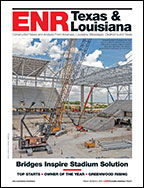Momika confirms the absence of skilled subcontractors experienced in sports stadiums. For Anwar Soura, site security is also an issue, even though Basra is a pretty calm city. There are also headaches regarding the safe passage to the site of imported goods.
The myriad obstacles did not stop 360 Architecture from offering one of its most complex cable-stayed coverings, with many ridges and valleys and serpentine trusses. Momika points to the "high-level design for the roof" as Anwar Soura's single-biggest construction challenge.
The seating bowl is standard cast-in-place construction—but not for Iraq, creating a concern about concrete quality. The concrete frames are spaced on grid lines approximately 12 meters on center around the stadium bowl. The lateral systems is shear walls in the radial direction and moment frames in the circumferential direction, to resist wind and seismic forces.
The canopy structure, covered by a polytetrafluoroethylene tensile membrane, resembles a bicycle wheel laid flat. The wheel bears on 48 steel-pipe truss masts, each with three chords. The masts are equally spaced outside of and around the perimeter of the bowl.
A steel-pipe funicular–shaped outer compression ring, located four meters above the top row of seating, runs continuously around the structure and connects the 48-m-tall masts. The compression ring resists tensile forces from the lower suspension cable and valley cables. It also collects the canopy's lateral forces and transfers them to vertical cable bracing at four locations.
The suspension cables radiate toward a funicular-shaped inner tension ring made of eight steel cables. The tension ring resists the upper and lower suspension cables and collects the canopy's lateral forces. The upper suspension cable at the top of the mast is resisted by a single backstay cable tiedown that terminates in the foundation. The mast base and tiedown are founded on a pile cap on top of an auger-cast pile foundation.
A tri-chord serpentine-shaped steel-pipe truss spans from each mast, sweeping horizontally to the inner tension ring and beyond it, cantilevering up to 10.5 m to form a forward span. The horizontal tri-chord trusses—essentially the wheel's spokes—also cantilever beyond the masts to create backspans.
"It is challenging structurally to work out the forces in the serpentine shape," says TT's canopy designer. "Engineering-wise, it is much easier just to connect the dots."
The serpentine trusses cantilever 10.5 ft beyond the tension ring to keep the suspension cables in a pure radial layout, says the engineer. They culminate at an inner ring of steel-pipe trusses.
The upper chord of each tri-chord serpentine truss forms a ridge of the membrane. The inner edge of the membrane is connected to the inner ring of pipe trusses, 32 m above the event level. The inner ring of secondary trusses creates a catwalk that supports lighting while also providing torsional support to the serpentine trusses. There is a span of 46 m from the outer circumference of the membrane to the inner edge.
The membrane has 12-m-wide standard-translucency panels, with 12.5% light transmission, between serpentine trusses. The engineer was required to provide cables that outline a ridge-and-valley profile for the membrane, to avoid a flat surface that would allow rainwater to collect. A high-translucency membrane with 38% light transmission, much like a clerestory, extends between serpentine truss bottom chords.











